Oriental Beauty Force Decorates the Gardens with its bright yellow flower-bells of early spring, as soon as snow comes. This decorative shrub is unpretentious in care, but in harsh conditions needs reliable shelter for the winter. In Siberia, Forzion is aggregated, but mostly cultivating frost-resistant varieties.
Forzing in Siberia, Culture Features
- The genus is represented by small leaf padded trees and shrubs, which relate to the Maslin family.
- His name received in honor of the notable gardener of England of the XVIII century - foresight. It was he who opened Europe the beauty of Forzition, which brought from China.
- Forzition is considered an ancient culture belonging to the Cenozoic era. All its types, except for one grow in Asia. This gene does not differ in diversity and consists of only eight species of subtropical origin, but only five are grown in culture.
- Depending on the type of formation, it grows from 1 to 3 m in height, less often up to 6-7 m. The diameter of the bush on average reaches 2-2.5 m.
- The view is leaf fall. The leaves are simple, oval shape, along the edge are notched, the arrival is missing. The sheet can be up to 15 cm long. The leaves begin to bloom at the end of flowering. At this time, the bush is actively acquired by new shoots that bloom the next spring.
- Soothes branches, reprehension, covered with gray-brown or bluish bark.
- Flowers bright yellow color, bell-shaped. Abundantly cover branches during flowering period, the leaves at this moment are missing, which gives the formation of special splendor and decorativeness.
- Fruz fruit - boxes with seed covered. To obtain seeds, it is necessary to overstate different types.
- Forzition - power supply for butterflies, caterpillars and other insects.
- Forzing is crying is one of the important components of Chinese medicine. And in Korea from the rhizomes of the judication, the beds for string tools are made.
Print forzing for growing in Siberia
In Siberia, gardens and household plots are decorated with frost-resistant forties. But even at very low temperatures can freeze. Especially strong kidney suffer, but the plant after trimming is rapidly restored.
Winter-hardy forms of Forzition:
- Forzia european - three-meter shrub whose crown has an ovoid shape. Forsius foliage bright green, the location is opposite. Flowers of traditional bright yellow color, sit in three in the sinuses of the leaves. Flowers dumped, up to two cm long, in the form of a bell. The species is common not only in culture, but also in nature in Europe. Flowers and fruit annually. It is considered the most frost-resistant representative of the genus.
- Forzing Girald - Guest from North China. The foliage of the elliptical form with a pointed top, the color passes from dark green to pale green. Flowers multiple, large, golden yellow. In winter, the European Forzing is quite a bit inferior, and eagerly grows in Siberia.
- Forzia ovate-shaped - low bush (up to 1.5 m in height) with a spreaded crown. The natural range of growth is the Korean Peninsula. Egg-shaped foliage, up to 7 cm long, bright green color. It is a presenter-drying type of forzition, has a moderate winter hardiness.
- Forzing Intermediate - three-meter bush with straight shoots, large bright green leaves and golden flowers collected in inflorescences. Frost-resistant, but needs good shelter for the winter.
Also in Siberia, many varieties of forzing derived from frost-resistant species are grown:
- Beatrix Frandand - branched Crown up to 4 m in height, rich-yellow flowers with a darker band at the base;
- Linwood - Abdominal hybrid, flower in diameter 3-4 cm, the leaves gradually change the color from green to purple, the height of the bush is 3 m;
- Fiesta. - a dwarf bush tall up to 150 cm, large flowers, golden yellow. The foliage is rich-green with a golden chip, decorated with decorative specks;
- Veriegata. - Pepling variety with small gear leaves and conventional flowers;
- Spring Glori. - A variety with an unusual coloring of the leaves: with the approach of autumn leaves become brown-violet or gentle yellow. Middle size flowers - 2-3 cm in diameter;
- ParkDekor - The grade withstands even the most severe climatic tests. It is famous for large buds up to 6 cm in diameter;
- Dresden Fongryuling - A variety of egg-shaped forsi, flowers up to 4 cm in diameter, height of the kestic up to 2 m, richly blooms in early spring.
Forzing in Siberia, landing and care
Forzing is only a guest in our gardens, which is designed to dilute the seafood of the landscape background in early spring. Therefore, it needs to create special conditions for growth in different regions of our country. It is especially important to pay the necessary care to Siberia to this plant, where the forzia is difficult to delight every year to delight with their flowering due to climatic conditions.
Conditions for landing forsias in Siberia
The forside place is required solar or moderately shaded. It is desirable that the shrub is reliably protected from the winds. Therefore, there should be reliable protection in the form of a garden structure and trees around the selected place.
The soil for forzing should be enriched with microelements (you can use humid and leafy land). Its structure should be loose, breathable, moisture stagnation is not allowed. The soil will need lime, so acidic and very heavy soils need to prepare in advance to landing.
Important! Forzing drought-resistant culture, so stagnation of groundwater and the absence of soil aeration lead to shrub death.
Dates of landing forzing to the ground in Siberia
In Siberia, it is desirable to plant seedlings with a closed root system that are grown in containers. This ensures the most rapid rooting and acclimatization of the seedlings.
Put the landing is better in the fall. Landing in spring time does not allow to eliminate the mealing of the kidneys. In addition, the wedding landing can end with the full extinction of growth points and rhizomes. But if weather conditions are favorable, you can land forzing in the spring, providing her care as an adult plant.
In the fall, landing is carried out at least a month before the onset of cold weather, so that the seedling manage to be reliably rooted and survive the winter. Therefore, it is necessary to focus more on the weather, and not the exact time of the disembarkation.
Forzing in Siberia, landing
Saplings are planting according to such a scheme:
- At a permanent place, the seedlings are planted in autumn if several plants landing are carried out, withstand a distance of about 2 m.
- It is prepared a hole with a depth of 60-70 cm, its diameter should be about 50 cm.
- Drainage is placed on the bottom - 20 cm of ceramzit or broken bricks are enough. From above additionally pour 10 cm of sand.
- Then the fertile soil poured into the pit, the rhizome of the seedling is immersed in the pit, fall asleep by the soil, they are tamped.
- After landing, watering and mulch the rolling circle.
Forsion care on the site
Growing in Siberia, Forzing will need more thorough, but easy care. The focus should be given to feeding and proper shelter for the winter.
- Watering. Forzing feels comfortable in dry soil, so in non-fit weather or the rainy season, it does not need it. If on the street drought, the bush is watered every two weeks, while spending 12 liters of water for one plant. After irrigation, the soil loans are 15 cm in order to ensure the influx of air and moisture to the rhizomet. After this procedure, the soil is sprinkled with mulch.
- Feeding. Fertilizers make three times in the season. An early spring in the rolling collar is scattered with a recoverable organic, excluding the navigation on the roots and shoots. In April, the complex fertilizer uses 70 g per 1 sq. M. m. And after flowering, the bush is fed by Kemio-Universal (100-130 g / 1 square meters).
Trimming and wintering forsii in Siberia
- Young Busta Bustzes need moderate sanitary trimming: removing dried, extinct or broken branches. Adult bushes are cut to form a crown or in the case of the frozen of the top shoots.
- The main trimming is carried out in the summer after flowering. The twigs that beat away are cut into ½ length, and all old shoots are cut at 60 cm above the ground. It stimulates the growth of new shoots, which will abundantly bloom the next spring.
- If you need to rejuvenate the bush, all shoots are cut into a height of 5-6 cm or 2/3 of the height, but it can be done no more than 1 time in 4 years.
Advice! With the help of decorative trimming, it is possible to give a black-shaped chip-like silhouette, as well as control its height.
By winter, forsius is prepared from autumn. In Siberia, even frost-resistant species are covered so as not to make floral kidneys. Preparation comes down to pressing escapes to the ground, sprinkling them with foliage or underfloor material (it must be able to pass air). Before the shelter for the winter, the bush is the last time abundantly watered. In the spring, when the temperature has already been normalized, the shelter is removed.
Fighting pests and diseases of Forzition in Siberia
Forzing is resistant to most diseases and pests, but sometimes the plant is nevertheless. What problems can be encountered in the process of cultivation of Forzition:
- Withering. If at the time of active flowering, some branches began to wither and die, you need to immediately treat the plant affordable fungicide. You can also carry out the prevention of this disease twice a season.
- Bacteriosis. The disease is manifested by the sudden yellowing of the leaves along the edge. Over time, the disease amazes the rest of the plant, completely destroying it. Another sign of bacteriosis is a darkening of the vessels on the cut. To prevent the spread of infection, the affected parts of the bush are removed and burned.
- Nematodes. Microscopic round worms affect the leaves, causing their darkening, drying and fading. Soon, thinned leaves become transparent, the plant dies. As treatment, the rooting of the sculptures of the cuttings and the destruction of the patient's bush is used.
- Aphid. It is easy to notice this insect on the leaves, so it is better to closely monitor the bush and to process from Tly on time. After the insect lesion, the leaves are covered with sticky raid, dry. The solution of the economic soap and potassium chloride helps to get rid of the threshold.
Propulation of Forzition in Siberia
The optimal method of breeding forssee is vegetative. The reproduction of seeds is practically no applied, since the complexity of obtaining seeds and their further cultivation creates a lot of problems and does not always end with success.
How to carry out shirts:
- In June, there are several green cuttings with a length of 15 cm and more. Or use semi-respene cuttings, which are prepared in the fall and store all winter in the basement in a wet environment.
- Reproduction is carried out in greenhouse conditions. You can roighten the cuttings and in the open ground, but the risk of freezing the cutting of the winter is very high.
- The cuttings remove the lower leaves, and then immerse them in a solution of any stimulator of root formation for 6 hours.
- The cuttings are rooted in the sand at a distance of 7-9 cm from each other. The depth of the recess of the cutter is 4 cm.
- In hot weather, cuttings are watered several times a day.
- The rooting occurs after 4-6 weeks.
Reproduction with tanks:
- In the summer, the escape is chosen, growing close to the surface of the soil.
- Make a small incision on the crust. The base of escape is pulled by wire, flex and fix. Then roll soil.
- The rooting passes within a few weeks and a year later, the young bush blooms abundantly.
Forzing in Siberia, photo
The magnificent outfit of the Forsius looks beautifully in a duet with coniferous cultures. Also, Forzition successfully revitalizes any slope, will create a magnificent background for flower beds, or the role of living hedges will play. Compact bushes will decorate the mountainaries or help to arrange walls and garden buildings. Forty and single landings are beautiful.

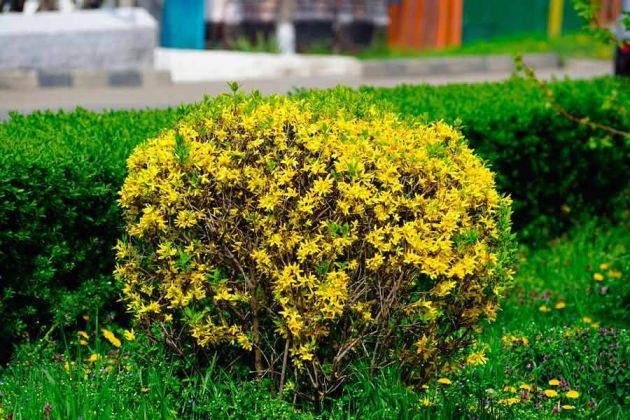
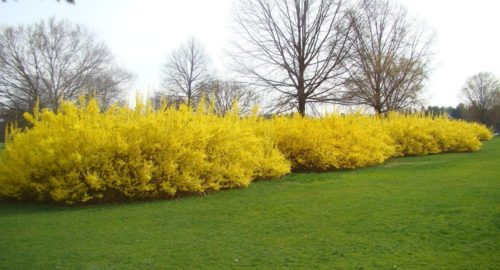
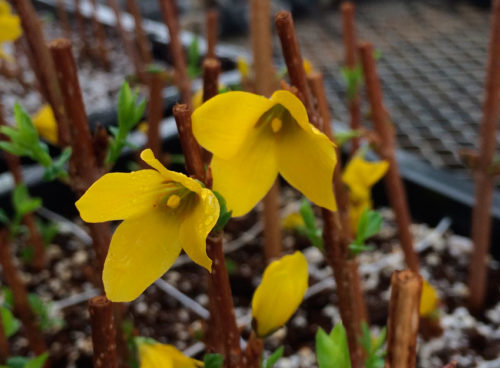
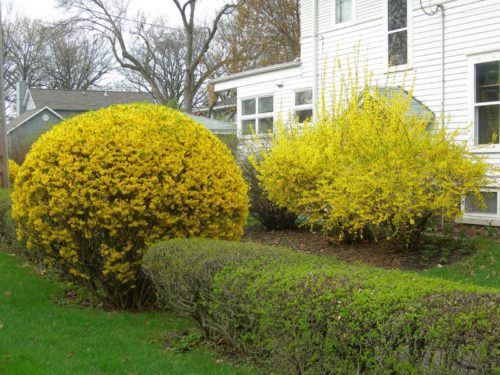
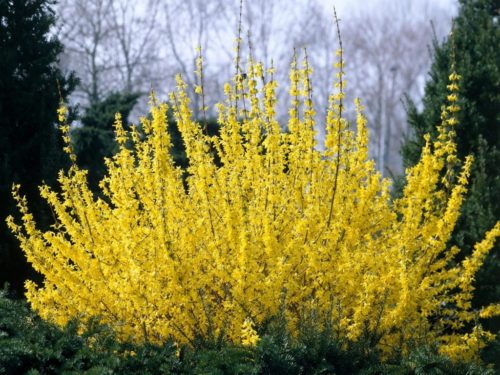
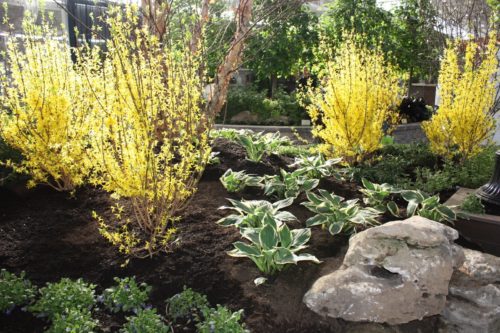
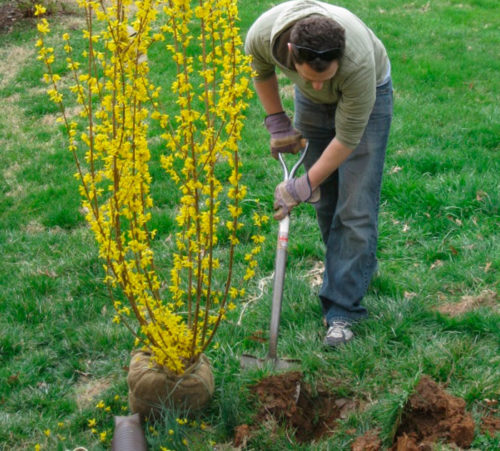

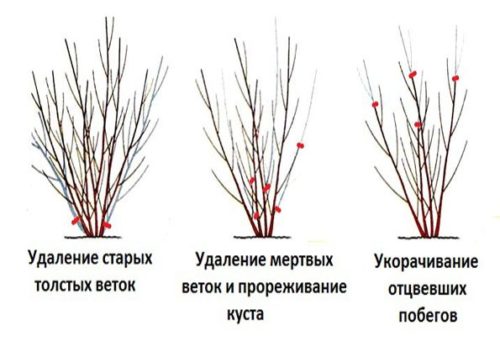
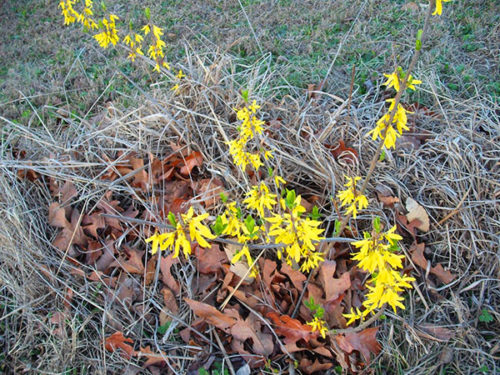
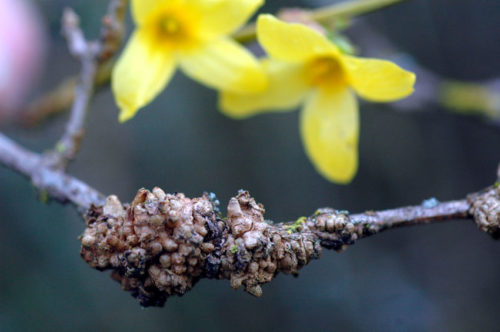
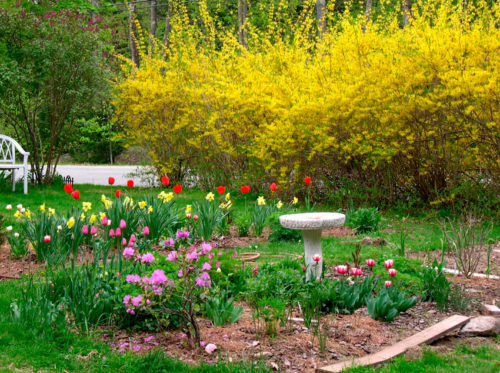
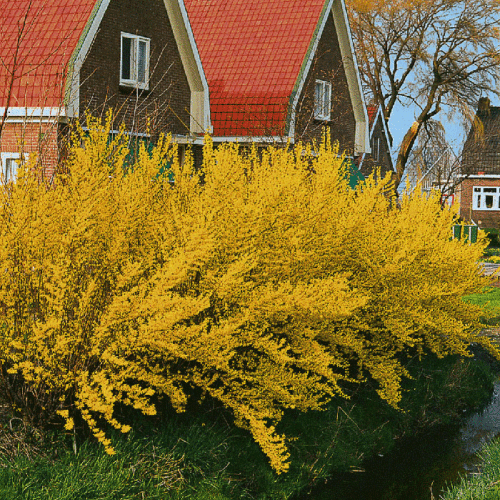
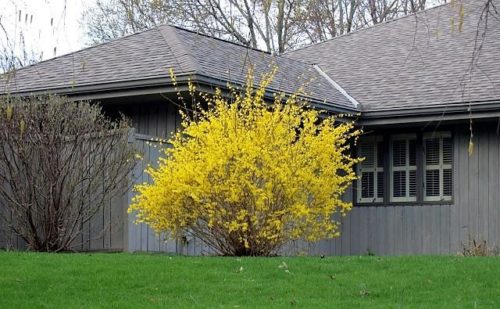












 Start a discussion ...
Start a discussion ...